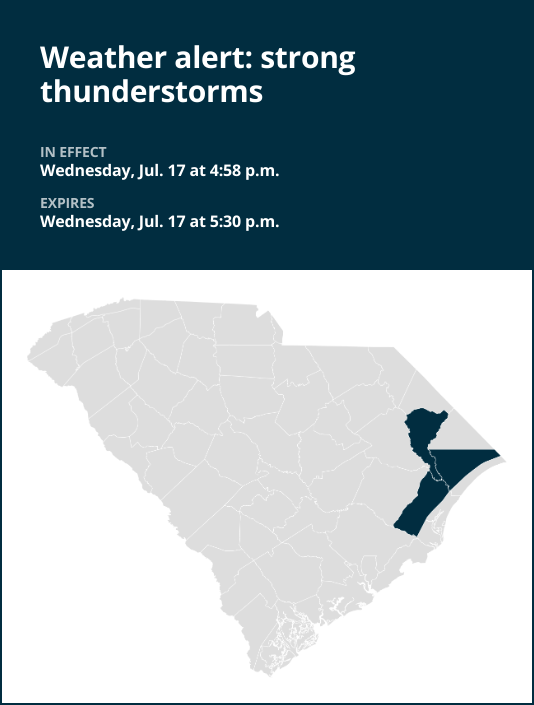A report was issued from the National Weather Service on Wednesday at 4:58 p.m. for strong thunderstorms until 5:30 p.m. for Marion, Georgetown and Horry counties.
Residents can look for wind gusts of up to 40 mph.
“At 4:57 p.m., Doppler radar tracked a strong thunderstorm over Dongola, or 11 miles southwest of Conway, moving northeast at 15 mph,” says the weather service. “Gusty winds could knock down tree limbs and blow around unsecured objects.”
Locations impacted by the alert include Red Hill, Bucksville, Dongola, Pee Dee Crossroads, Yauhannah and Bucksport.
The weather service comments, “If outdoors, consider seeking shelter inside a building.”
This alert is in effect until 5:30 p.m.

Shielding yourself from approaching lightning: Expert safety guidelines
Each year, lightning strikes the United States approximately 25 million times, with the majority of these electrifying events occurring during the summer months. Unfortunately, lightning is responsible for claiming the lives of approximately 20 people annually, as reported by the weather service. The threat of lightning becomes more pronounced as thunderstorms draw nearer, peaking when the storm is directly overhead and gradually waning as it moves away.
To ensure your safety during a thunderstorm, keep these recommendations in mind:
Lightning safety plan:When venturing outdoors, it’s crucial to have a lightning safety plan in place.
Stay vigilant by monitoring the sky for ominous signs and listening for the telltale sound of thunder. If thunder is audible, it’s a clear indication of nearby lightning.
Seek shelter promptly in a safe location, preferably indoors.
Indoors safety measures:Once you’re indoors, avoid using corded phones, electrical devices, plumbing fixtures, and stay away from windows and doors.
Lightning can follow conductive pathways, and these precautions reduce the risk of electrical surges.
Wait for the all-clear:After the last lightning strike or thunderclap, wait at least 30 minutes before resuming outdoor activities.
It’s important to remember that lightning can strike even when a storm seems to have passed, so exercise caution.
When indoor shelter isn’t available:If you find yourself outdoors without access to indoor shelter during a thunderstorm, take these steps to maximize your safety:
Avoid open fields, hilltops, or ridge crests, as they expose you to greater lightning risk.
Steer clear of tall, isolated trees and other prominent objects. In forested areas, stay close to lower stands of trees.
If you’re with a group, ensure individuals are spread out to prevent lightning current from transferring between people.
Camping in an open setting during a thunderstorm is strongly discouraged. If no alternative exists, set up camp in a valley, ravine, or other low-lying areas. Remember that a tent offers no protection against lightning.
Do not approach water bodies, wet objects, or metal items. Although water and metal do not attract lightning, they conduct electricity effectively and can pose significant risks.
In summary, when facing the threat of lightning, preparedness and vigilance are your best allies. By following these guidelines, you can significantly reduce the likelihood of lightning-related incidents and prioritize your safety.
Rainy roadways ahead: Essential safety tips for heavy rain
When heavy rain strikes, safety is paramount. Equip yourself with these guidelines from the weather service to navigate wet roads and avoid hazards:
Beware of rapid water flow:During heavy rain, avoid parking or walking near culverts or drainage ditches, where swift-moving water can pose a serious risk.
Maintain safe driving distances:Adhere to the two-second rule for maintaining a safe following distance behind the vehicle in front of you. In heavy rain, allow an additional two seconds of distance to compensate for reduced traction and braking effectiveness.
Reduce speed and drive cautiously:On wet roads, slowing down is paramount. Gradually ease off the accelerator and avoid abrupt braking to prevent skidding.
Choose your lane wisely:Stick to the middle lanes on multi-lane roads to minimize the risk of hydroplaning, as water tends to accumulate in outer lanes.
Prioritize visibilityEnhance your visibility in heavy rain by turning on your headlights. Watch out for vehicles in blind spots, as rain-smeared windows can obscure them.
Watch out for slippery roads:The first half-hour of rain is when roads are slickest due to a mix of rain, grime, and oil. Exercise heightened caution during this period.
Keep a safe distance from large vehicles:Don’t follow large trucks or buses too closely. The spray created by their large tires reduces your vision. Take care when passing them as well; if you must pass, do so quickly and safely.
Mind your windshield wipers:Heavy rain can overload the wiper blades. When visibility is so limited that the edges of the road or other vehicles cannot be seen at a safe distance, it is time to pull over and wait for the rain to ease up. It is best to stop at rest areas or other protected areas.
If the roadside is your only option, pull off as far as possible, preferably past the end of a guard rail, and wait until the storm passes. Keep your headlights on and turn on emergency flashers to alert other drivers of your position.
By following these safety measures, you can significantly reduce risks and ensure your well-being when heavy rain pours down. Stay informed about weather conditions and heed advice from local authorities to make your journey safe and sound.







